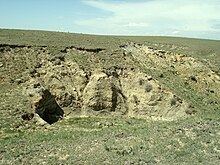Thickness 200-400 ft (60-120 m) Country USA Primary Sandstone, Mudstone, Coal | ||
 | ||
The Laramie Formation is a geologic formation of Late Cretaceous (Maastrichtian) age, named by Clarence King in 1876 for exposures in northeastern Colorado, in the United States. It was deposited on a coastal plain and in coastal swamps that flanked the Western Interior Seaway. It contains coal, clay and uranium deposits, as well as plant and animal fossils, including dinosaur remains.
Contents
Stratigraphy and Lithology
The Laramie Formation is exposed around the edges of the Denver Basin and ranges from 400–500 feet (120–150 m) on the western side of the basin, and 200–300 feet (60–90 m) thick on the eastern side. It rests conformably on the Fox Hills Sandstone and unconformably underlies the Arapahoe Conglomerate. The formation can be divided into an unnamed lower member containing bedded sandstone, clay and coal; and an unnamed upper member composed predominately of 90 to 190 m of drab-colored mudstone, some sandstone, and thin coal beds. Nodular ironstone concretions occur in the mudstones that contain plant remains. Some of the material in the sandstones originated from silicic volcanoes far to the west.
Paleofauna
Fossil vertebrates from the Laramie Formation were among the first dinosaurs to be discovered in the American West (Carpenter and Young 2003). In 1873, Edward D. Cope accompanied Ferdinand V. Hayden, who was leader of the U.S. Geological and Geographical Survey of the Territories. The route of the expedition included eastern Colorado where Cope collected specimens in what is now the Laramie Formation along Bijou Creek on the east side of the Denver Basin (Cope, 1874).
Cope named three species of dinosaurs without description: Cinodon arctatus (later changed to Cionodon arctatus), Polyonax mortuarius and Agathaumas milo (later renamed Hadrosaurus occidentalis). These specimens are currently in the American Museum of Natural History. These specimens are very scrappy and the names no longer considered valid. Subsequent discoveries of dinosaurs occur through the formation, and include a nearly complete skull of Triceratops. Non-dinosaur vertebrates also occur (Carpenter 1979).
List of Fossil Vertebrates (data from Carpenter 1979; Hutchinson and Holroyd 2003)
Paleoflora
Fossil pollen (palynomorphs) include bryophyte and pteridophyte spores, gymnosperm pollen, and abundant angiosperm pollen, including Aquilapollenites striatus, Ilexpollenites compactus, Interpollis cf. I. supplingensis, and Tricolpites interangulus. The palynomorphs indicate an early Maastrichtian age (68-69 mya), which is supported by magnetostratigraphy. Magnetostratigraphy also shows that the Laramie Formation becomes progressively younger eastward as deposition followed the regression of the Western Interior Seaway.
Fossil leaves are abundant, especially in the shales and sandstones associated with coal. Dicot angiosperms dominate, with lesser amounts of ferns, palms, and herbaceous lycopods. Interestingly, conifers are rare. Common plants include “Ficus” planicostata, “Myrica” torreyi, Sabalites sp., Platanites marginata, and Marmarthia pearsonii.
